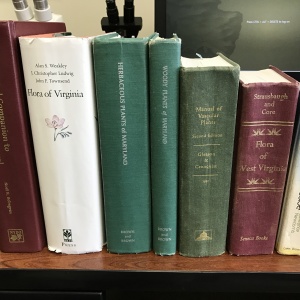The last week of June has been glorious in terms of weather but the rest was very hot and humid. I had the opportunity to participate in a few non-plant related activities recently. I assisted with a breeding bird survey and tagged along with the park’s geologist intern to visit some caves and poke around for fossils. I still got out to do some plant surveying though.
One plant that occasionally gets overlooked by some is Polygonatum pubescens (Hairy Soloman’s Seal). It grows alongside and appears very similar to another species within this genus, Polygonatum biflorum (Soloman’s Seal). Fortunately, once you are aware of the two species they are easily distinguished even without flowers. The leaves of Polygonatum pubescens have lines of hairs on their underside while Polygonatum biflorum’s leaves are glabrous throughout.

Polygonatum pubescens (Hairy Soloman’s Seal)

Polygonatum pubescens (Hairy Soloman’s Seal) A close-up of the leaf underside showing the rows of hairs along the veins. Folding it over the finger like this seems to be the best way to see them. A hand lens is not required to see them.
I feel obligated to mention that distinguishing the genus of Polygonatum in a vegetative state from other similar genera took me several seasons to learn. Some of the genera that can look similar to Polygonatum in the eastern U.S. are Maianthemum spp., Uvularia spp., Prosartes spp., and Streptopus spp. It’s also worth mentioning that the synonym for Maianthemum is Smilacina while the synonym for Prosartes is Disporum. Distinguishing these genera when in flower is a lot simpler. However, typically Polygonatum spp. can be separated from Maiantheum racemosum by leaf margin characters and these two genera I just mentioned can be separated from Prosartes spp. and Streptopus spp. by whether or not their stalks are forked. I have never personally seen Streptopus spp. in the field.
I also found Ruellia strepens (Limestone Wild Petunia) in flower this month and realized just how inconspicuous it is when it is not in flower. The common name of this plant is slightly misleading. Although it may grow predominately in limestone areas it is not limited to them. One of the populations I found was around the Potomac Gorge area in a floodplain forest. This species is listed in Maryland as a S2S3.

Ruellia strepens (Limestone Wild Petunia)

Ruellia strepens (Limestone Wild Petunia) The calyx lobe width is an important character in distinguishing species within this genus.
Not far from where I found the Ruellia I checked out a rocky river outcrop along the Potomac and found two other state listed species. One of those species was Trachelospermum difforme (Climbing Dogbane) which I discussed in a blog entry last season and is an S1 (Endangered) species. The other was Hibiscus laevis (Halberdleaf Rosemallow) an S3 (Watchlist) plant. I guess the interesting thing about the photos I took is that they show each plant in an immature state.
I should note as I stated in my previous entry that leaf shape for climbing dogbane is listed as “variable” in the manuals. To my eyes the young leaf grow was linear and narrow with more vigorous/older stems showing the orbicular and wider leaf shape I was used to seeing. With that said I can’t be certain if these young “narrow leaves” will retain their shape as they grow or morph into the orbicular form. I also can’t be certain whether or not this narrow growth is a result of physical damage to the stems. The stems are exposed to potential damage from flooding and visitor trampling. Additionally, in my previous post I neglected to mention that some species descriptions for climbing dogbane state that milky sap is not always detected when its tissue is broken. As with all populations I have encountered on the Potomac, these plants did have milky sap.

Trachelospermum difforme (Climbing Dogbane)

Trachelospermum difforme (Climbing Dogbane) The population was in fierce competition with Campsis radicans, Toxicodendron radicans, and the non-native shrub, Ulmus pumila.
Halberdleaf Rosemallow is not especially uncommon along the Potomac River. The pictures I took captured it at about the half way point in terms of its growth height. The leaf shape is very distinctive. It could be confused with Hibiscus moscheutos (Crimsoneyed Rosemallow) which can have slight lobing of the basal portions of some leaves. Typically Halberdleaf Rosemallow holds true to its name and possesses well defined lobes throughout. One of the interesting observations I noted from this population was the deformities in the leaves as seen in the pictures.

Hibiscus laevis (Halberdleaf Rosemallow)

Hibiscus laevis (Halberdleaf Rosemallow)

Hibiscus laevis (Halberdleaf Rosemallow) This picture shows an example of the leaf deformities I observed. This type of deformity occurred in every clump of plants though varied in abundance on each stem.
I’ve crossed the halfway point of my internship once more. July will be a busy month because many of the G1-G3 priority species on my list are flowering in that period. July on the Potomac is particularly exciting for me because the decrease in rainfall that usually occurs opens access to certain islands and scour bars on the river where so many interesting and rare plants grow.























































